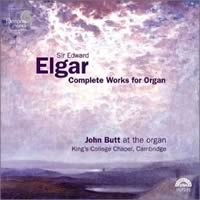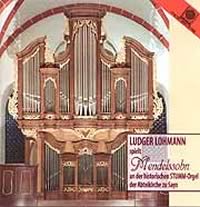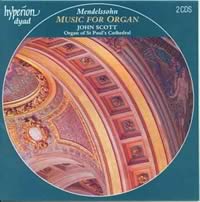Pump and Circumstance
|
W.A. Grieve-Smith [March 2004.]
Edward ELGAR: Complete Works for Organ. John Butt (organ). Harmonia Mundi HMU 907281 (http://www.harmoniamundi.com/). (2000) [66:55] Sonata No. 1 in G, Op. 28 (1892); Vesper Voluntaries, Op. 14 (1890); Cantique in C, Op. 3, No. 1 (1879/1912); Loughborough Memorial Chime (1923); Sonata No. 2 in B-flat major, Op. 87a (1933). A former organ scholar at King’s College, Cambridge, Butt returns to the organ at King Henry VI’s famous chapel. The organ case, a possible survivor from Thomas Dallam’s 1605/6 instrument, sits in the most acoustically favorable position possible: smack dab atop the rood screen that separates the choir from the congregation (nave). In 1859 William Hill doubled the depth of the Cambridge case to accommodate more pipes, possibly including French reeds Henry Willis purchased from Cavaillé-Coll in Paris. The King’s organ pedal reeds sound almost identical. In 1934, 1968 and 1992 Harrison and Harrison of Durham updated and regulated the organ. So here’s a superb instrument in one of the most spectacular acoustic environments in the Western World. If you’re expecting sugary, syrupy sentimental twaddle, think again! In spite of being one of the most Victorian of the Victorians, Elgar’s organ compositions hark back to an earlier English tradition, that of Mozart’s pupil Thomas Attwood and the most illustrious of early Victorian organ recitalists, Felix Mendelssohn. The organ sonatas could easily be mistaken for Mendelssohn’s, complete with Bachian fugal passages. Opening allegros swagger with Elgarian pomp, but the quieter sections could be Songs Without Words. The Vesper voluntaries are quiet meditations suitable as backgrounds for private prayer. Harmonia Mundi is to be commended for bringing us a CD which captures both the limpid, singing flutes and the floor-shaking pedal notes worth hearing for their own sake.
Felix MENDELSSOHN: Ludger Lohmann spielt Mendelssohn an der historischen STUMM-Orgel (1778) der Abteikirche zu Sayn. Motette CD 12471 (http://www.motette-verlag.de/). (1998) [72:12] Präludium und Fuge d-Moll; Präludium und Fuge G-Dur; Allegro d-Moll; Andante F-Dur; Andante D-Dur; Sonata II c-Moll; Sonata IV B-Dur; Sonata VI d-Moll. Herr Prof. Dr. Lohmann very stylishly emphasizes the Bachian-Classical affinities of Mendelssohn’s compositional style, as opposed to the Romantic style. And he employs an organ of the type that Mendelssohn played during the last decade of his life, an organ with which Bach himself would have been quite comfortable. The reeds have a slight French accent reminiscent of the Alsatian Silbermann instruments that Bach played. Around 1840, Eberhard Friedrich Walcker started building German organs in the Romantic orchestral style, but this trend seems to have been foreign to Mendelssohn’s aesthetic. In the U.S. of A., the most famous Walcker organ was imported for the Boston Music Hall in the 1850s and now resides in its own museum in Methuen, Massachusetts. The style of the Walcker case was also copied for the organ in the Mormon Tabernacle. Both of these have been completely rebuilt by G. Donald Harrison of the Aeolian-Skinner Company. It must be remembered that in the 1840s even musicians knew little of J.S. Bach’s music beyond The Well-Tempered Clavier. The heritage of “the 48” is very apparent in Mendelssohn’s Preludes and Fugues for organ. Mendelssohn’s organ compositions remind one of Mozart’s orchestrations of Handel and Bach. Mozart’s pupil Thomas Attwood invited Mendelssohn to give recitals on the organ of St. Paul’s Cathedral, where Attwood was the titulaire. In both oratorio and organ composition, Mendelssohn set the tone for British church music throughout the Victorian era, culminating in the works of Elgar and Ralph Vaughan Williams.
Felix MENDELSSOHN: Music for Organ. John Scott (organ of St. Paul’s Cathedral, London). Hyperion Dyad CDD 22029 (http://www.hyperion-records.co.uk/). (1990) [138:52, 2 CDs priced as one] Available from http://www.gothicrecords.com/. Prelude and Fugue No. 1 in C minor; Prelude and Fugue No. 2 in G; Prelude and Fugue No. 3 in D minor; Sonata No. 1 in F minor; Sonata No. 2 in C minor; Sonata No. 3 in A; Sonata No. 4 in B flat; Andante in F; Allegro maestoso in C; Andante in D; Fugue (Allegro) in E minor; Fugue (Lento) in F minor; Sonata No. 5 in D; Allegro in B flat; Sonata No. 6 in D minor; Allegro, Chorale and Fugue in D. John Scott plays his Mendelssohn in St. Paul’s Cathedral with its 12-second reverberation on a Henry Willis instrument restored by Noel Mander. Though it may indeed contain pipes that sounded under Mendelssohn’s fingers, it’s now the epitome of the Brit cathedral organ, French-style. And Scott’s Mendelssohn sounds even more Romantic than Prof. Lohmann’s readings. Nevertheless, Willis’ combination of narrow-scale flue pipes with French reeds is an enthralling one that even the French miss. Scott may be accused of adding slightly more syrup and sentimentality than the music warrants. Yet the heft of a large instrument in a large space yields a gravitas that’s mighty appealing. And don’t miss the Echo Organ in the dome, used to convincing effect. With the Sonatas, Preludes and Fugues we encounter a first-rate composer at the top of his form. More’s the pity that the current prejudice against organ music in general and church music in particular keeps the public from hearing such well-crafted compositions. There is nothing inherently liturgical in Mendelssohn’s organ pieces. They are works for recitals or concerts on “of all instruments the King,” which mostly happen to be in churches these days. Recommended!
[More W.A. Grieve-Smith]
[More
Elgar, Mendelssohn]
[Previous Article:
Random Noise 7: To Be Listenin' or Not to Be Listenin']
|


